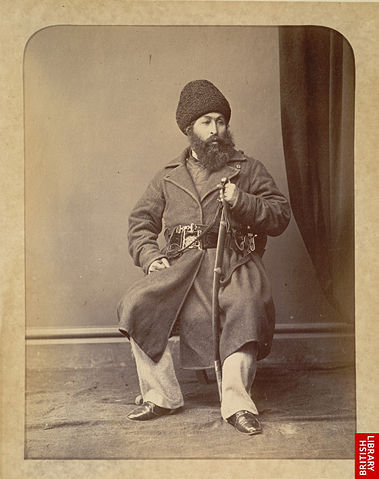| Description |
H.H. Amir Shere Ali Khan. Photograph of Sher Ali (1825-1879) Amir of Afghanistan, 1863–79, the son of Dost Muhammad, taken in 1869 by John Burke, from the album 'The Afghan War, Attock to Jellalabad, Gandamak and Surkhab.' John Burke accompanied the Peshawar Valley Field Force, one of three British Anglo-Indian army columns deployed in the Second Afghan War (1878-80), despite being rejected for the role of official photographer. He financed his trip by advance sales of his photographs 'illustrating the advance from Attock to Jellalabad'. Coming to India as apothecary with the Royal Engineers, Burke turned professional photographer, assisting William Baker. Travelling widely in India, they were the main rivals to the better-known Bourne and Shepherd. Burke's two-year Afghan expedition produced an important visual document of the region where strategies of the Great Game were played out. The Anglo-Russian rivalry (called the Great Game) precipitated the Second Anglo-Afghan War. Afghanistan was of strategic importance to the British in the defence of their Indian Empire, and the prevention of the spreading influence of Russia. They favoured a Forward Policy of extending India's frontiers to the Hindu Kush and gaining control over Afghanistan. In 1878 Sher Ali, who for the majority of his reign kept good terms with the British, was devastated by the death of his favourite son and his court was in disarray. The British were trying to establish a permanent mission at Kabul which Sher Ali, trying to keep a balance between the Russians and British, would not permit. The arrival of a Russian diplomatic mission in Kabul increased British suspicions of Russian influence and ultimately led to the Second Afghan War. The British undertook a three-pronged drive into Afghanistan, held the Khyber Pass and defeated the Amir's forces. Appointing his son Yakub Khan as regent, Sher Ali fled from his capital to take refuge in Russian Turkestan but died at Mazhar-e-Sharif on 21 February 1879. Yakub had to agree to the Treaty of Gandamak, whereby Afghanistan ceded to the British control of its foreign affairs, and the Khyber and Michni Passes, and allowed British representatives in Kabul and other locations. This photograph of the Amir actually dates from 1869 from the Ambala Durbar when he first entered into negotiations with the British. Burke reused it as part of the introduction to his Afghan War catalogue. |
Permission
( Reusing this image) |
|
|
This image (or other media file) is in the public domain because its copyright has expired.
This applies to the United States, Canada, the European Union and those countries with a copyright term of life of the author plus 70 years.
 Note that a few countries have copyright terms longer than 70 years: Mexico has 100 years, Colombia has 80 years, and Guatemala and Samoa have 75 years. This image may not be in the public domain in these countries, which moreover do not implement the rule of the shorter term. Côte d'Ivoire has a general copyright term of 99 years and Honduras has 75 years, but they do implement that rule of the shorter term. Note that a few countries have copyright terms longer than 70 years: Mexico has 100 years, Colombia has 80 years, and Guatemala and Samoa have 75 years. This image may not be in the public domain in these countries, which moreover do not implement the rule of the shorter term. Côte d'Ivoire has a general copyright term of 99 years and Honduras has 75 years, but they do implement that rule of the shorter term.
العربية | Asturianu | Български | Català | Česky | Dansk | Deutsch | English | Ελληνικά | Esperanto | Español | Euskara | فارسی | Français | Gaeilge | Galego | עברית | हिन्दी | Bahasa Indonesia | Italiano | 日本語 | 한국어 | Kurdî / كوردی | Lietuvių | Magyar | Nederlands | Norsk (nynorsk) | Македонски | Bahasa Melayu | Polski | Português | Română | Русский | Slovenčina | Slovenščina | Shqip | Suomi | Sámegiella | Türkçe | 中文(简体) | 中文(繁體) | 粵語 | +/- |
 |
This UK photograph or other artistic work (e.g. painting), of which the author is known, is in the public domain because the author died prior to 1st January 1938. This tag does not apply to engravings nor to musical works. |
|
|

